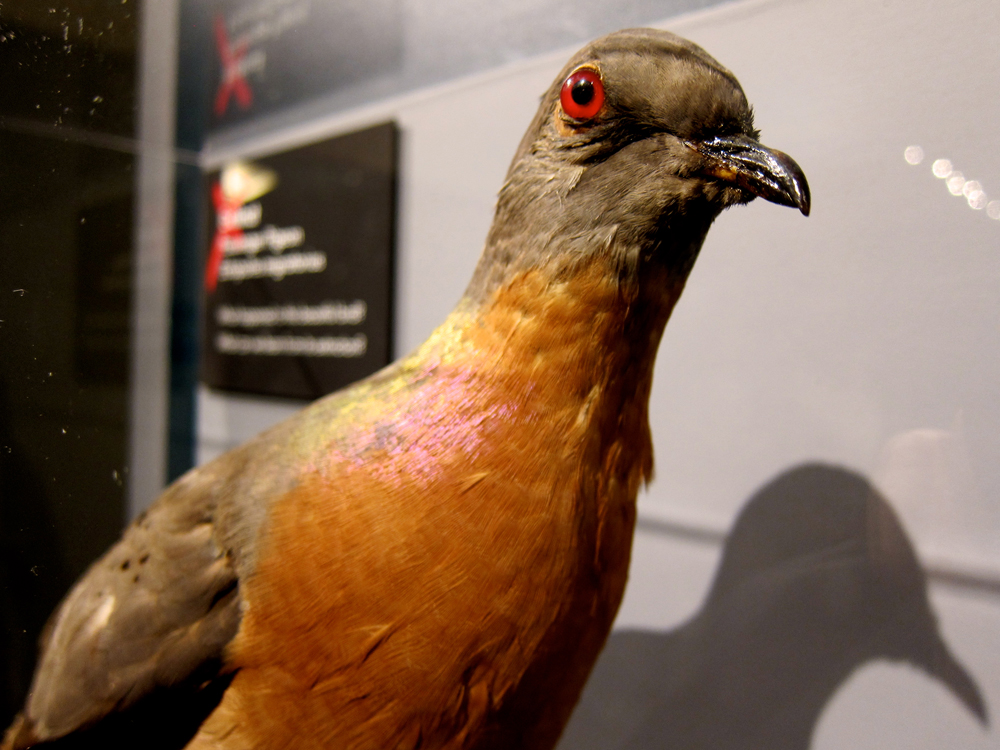100 Years Later: Remembering the Passenger Pigeon

CAMBRIDGE, Mass. — Passenger pigeons were once among the most abundant birds on Earth. They clouded North American skies during the 1800s with flocks boasting millions of birds that took hours to pass overhead and spanned hundreds of miles in length.
On Sept. 1, 1914 — a century ago this year — the last living passenger pigeon, named Martha, died at the Cincinnati Zoo, shocking the public and scientific community that such an abundant animal could fall so fast. The bird's legacy has helped establish modern conservation legislation such as the Endangered Species Act, and the species now stands as one of the top candidates for de-extinction — the controversial scientific effort to bring extinct species back to life.
Cousins of the feral rock pigeon common in many cities today, passenger pigeons were widely hunted for meat and feathers throughout the 1800s. Pigeoners would cast nets and catch hundreds or even thousands at a time as flocks migrated from breeding grounds in the Midwestern and Northeastern United States down to southern states during the winter.
Given the enormity of the flocks, hunters may not have realized they could ever put a dent in the bird's population, said Janis Sacco, director of exhibitions at the Harvard Museums of Science and Culture, who helped coordinate an exhibit commemorating the 100th anniversary of the bird's extinction here at the Harvard Museum of Natural History. [Images of Rare Passenger Pigeon Museum Specimens]
"This tendency to amass in such huge flocks gave the illusion that they were infinitely abundant," Sacco told Live Science.
Unlike other colonizing birds that form numerous flocks throughout a given range, passenger pigeons formed only a small number of very large flocks.
"They were very unique in terms of any bird that we see today," Kevin Johnson, an ornithologist at the Illinois Natural History Survey of the University of Illinois, told Live Science. "There really is no equivalent to the passenger pigeon."
Get the world’s most fascinating discoveries delivered straight to your inbox.
Hunters may not have realized the flocks they decimated were among only a handful that existed across the continent.
By the mid-1800s, railroads helped bring hunters ever closer to the birds' breeding grounds in the northern part of the country. From the 1850s through the 1870s, dents in the population became noticeable and worrisome to the public, but hunting went on, Johnson said.
Path to extinction
The birds relied primarily on their strength in numbers to defend against natural predators, and they never developed any other more sophisticated anti-predator defenses. So as humans demolished nests and killed thousands of birds year after year, the pigeons' primary form of defense weakened, and they became more exposed to raccoons and other predators that raided nests and further depleted their populations until they went extinct, Johnson said.
Americans had known of previous human-induced extinctions, such as that of the dodo bird in the 1600s, but never one of this scale. The demise of the bird struck a chord across the country that helped ignite the modern conservation movement, Johnson said.
"For the first time, people became aware that you could have this super abundant bird that everyone knew about, and that people could actually cause their extinction," Johnson said. "I guess that raised public awareness that humans can cause the extinction of animals on a scale that hadn't really been done before."
Legacy lives on
After Martha died, the Migratory Bird Treaty Act was established in 1918 to protect flocks of certain migratory birds from hunters without permits. This was one of the first of a string of legal movements to protect animals from human activities that ultimately led to the establishment the Endangered Species Act in 1973.
Today, several research groups across the country are working to use DNA from toe pads of museum specimens to bring the passenger pigeon back from extinction. Genetics research has advanced significantly in the past several years, and may allow scientists to bring the bird back into the world within the next several years, Ross MacPhee, a zoologist at the American Museum of Natural History told Live Science last month. The extent to which these animals would be released into the wild to re-create the massive spectacles of their flocks remains up for debate, MacPhee said.
Follow Laura Poppick on Twitter. Follow us @livescience, Facebook& Google+. Original article on Live Science.

